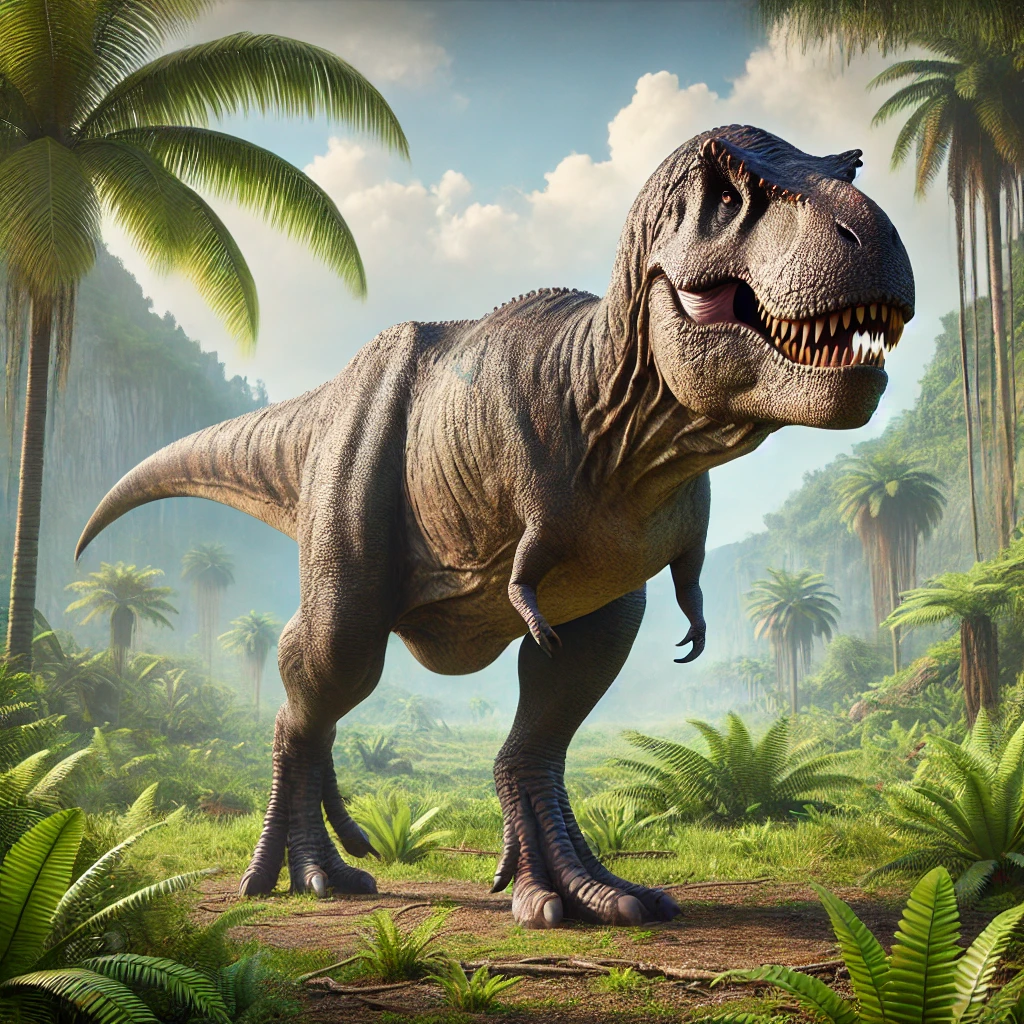Tyrannosaurus
Pronunciation:
Tie-ran-oh-sore-us
Name Meaning:
“King of the tyrant lizards”
Dinosaur Classification:
- Kingdom: Animalia
- Phylum: Chordata
- Class: Reptilia
- Order: Saurischia
- Suborder: Theropoda
- Family: Tyrannosauridae
- Genus: Tyrannosaurus
- Species: T. rex
Dinosaur Description:
Tyrannosaurus rex, often referred to as T. rex, is arguably the most famous dinosaur of all time. It lived approximately 68 to 66 million years ago during the Late Cretaceous period and was one of the last non-avian dinosaurs before the mass extinction event that wiped them out. T. rex was a massive theropod dinosaur, standing on two powerful legs, with an enormous skull balanced by a long, heavy tail.
The jaws of Tyrannosaurus rex were its most formidable feature, armed with large, conical teeth that could easily crush bone. These teeth, some of which measured over 12 inches (30 cm), were serrated, making them perfect for gripping and tearing through flesh. Its bite force is estimated to have been the strongest of any terrestrial animal, allowing it to take down large prey and crush bones to access the nutrient-rich marrow inside.
Tyrannosaurus rex stood up to 12 feet (3.7 meters) tall at the hips and measured up to 40 feet (12 meters) in length. Despite its massive size, evidence suggests that it was an active predator. Fossilized footprints and other traces indicate that T. rex had relatively good mobility, although it likely wasn’t the fastest dinosaur. Its forward-facing eyes gave it binocular vision, enhancing its depth perception—an important trait for a predator.
There has been considerable debate about whether T. rex was primarily a predator or a scavenger, but current evidence suggests that it likely filled both roles. It had the tools and physical prowess to hunt live prey, but it may have also scavenged carcasses when the opportunity arose, much like modern lions or hyenas.
T. rex’s arms, although small, were muscular and had two-fingered claws. It’s unclear what specific role these arms played in its hunting or feeding behavior, but they were likely useful for gripping prey or for stabilizing itself as it rose from a resting position.
Dinosaur Diet and Behavior:
Tyrannosaurus rex was a carnivore that fed on large herbivorous dinosaurs, including hadrosaurs and ceratopsians. It likely ambushed prey, using its powerful bite to incapacitate and kill. T. rex may have also scavenged, as it was equipped to consume both live animals and carrion.
Dinosaur Size:
Tyrannosaurus rex could grow up to 40 feet (12 meters) in length, with an estimated height of 12 feet (3.7 meters) at the hips.
Dinosaur Weight:
Tyrannosaurus rex weighed between 9 to 14 tons (18,000 to 28,000 pounds), making it one of the heaviest land predators known.
Fossil Discoveries:
The first T. rex fossil was discovered by Barnum Brown in 1902 in Montana, USA. Since then, numerous T. rex fossils have been found across North America, primarily in the Hell Creek Formation, Lance Formation, and other Late Cretaceous deposits. The most famous T. rex fossil is “Sue,” discovered in South Dakota in 1990. “Sue” is one of the most complete and well-preserved T. rex skeletons ever found and is housed in the Field Museum of Natural History in Chicago.
What Period Did The Dinosaur Live:
Tyrannosaurus rex lived during the Late Cretaceous period, approximately 68 to 66 million years ago.
Notable Facts or Trivia:
– T. rex is often depicted as the ultimate predator in popular culture, thanks to its imposing size and fearsome reputation.
– Its arms, while small, were extremely strong, and some researchers suggest they were used in mating or grasping prey.
– Tyrannosaurus rex had an incredible sense of smell, potentially one of the best among dinosaurs, which could have aided it in locating prey or carcasses over long distances.
Scientific Significance:
Tyrannosaurus rex is one of the most extensively studied dinosaurs, providing key insights into the physiology, behavior, and evolutionary biology of theropod dinosaurs. Research into T. rex’s bone structure, growth patterns, and biomechanics has given scientists a clearer understanding of how large predatory dinosaurs lived. Ongoing studies, including advanced imaging and analysis of T. rex bones, continue to reveal new information about this iconic species.
Extinction & Legacy:
Tyrannosaurus rex went extinct around 66 million years ago, during the mass extinction event that marked the end of the Cretaceous period. This event, likely caused by a combination of volcanic activity and a large asteroid impact, led to the extinction of nearly all dinosaur species. However, T. rex’s legacy endures in the public imagination as one of the most fearsome creatures ever to walk the Earth. Its fossils are displayed in museums around the world, and its cultural impact remains strong, particularly in films, literature, and documentaries.

